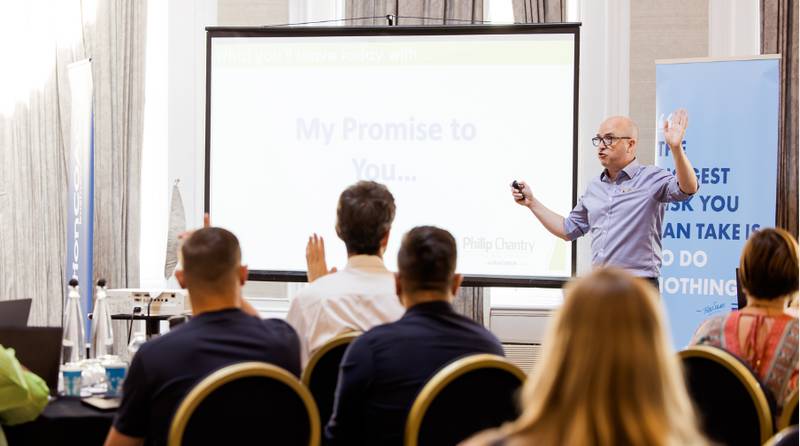Want to convert more potential leads into buying customers? Of course you do. Take a look at your sales process to see if it’s as effective as it could be. Created right, a well-defined sales process underpins your business. It gives your sales team a clear structure and a roadmap.
Effective sales processes boost conversions, turn more potential customers into closed deals, and ensure you provide a consistently good customer experience.
Boosted sales, more closed deals, greater customer experience – sounds like a powerful tool doesn’t it? Here, we’ll take you through the steps to creating a successful sales process and simple ways to improve your current one.
What is a Sales Process?
A sales process is a set of repeatable steps that your sales team takes to convert prospects into new customers. It’s not complicated, but it is a necessary path to follow. It provides a strategic framework to optimise efficiency, consistency, and deliver successful sales results.
The 7 Key Steps of the Sales Process
Let’s go through the nitty gritty of creating the sales framework. There are seven stages of the sales process to follow:
 1. Prospecting: who’s your ideal client? What challenges and pain points do they face and how can you help them? Really understand your target market, work out where and how to reach them. Then, decide how to engage with these potential customers. That outreach could be cold calling or emailing, in-person networking or via social media channels like LinkedIn. Oh, and don’t forget word of mouth recommendations from existing customers, they’re so powerful.
1. Prospecting: who’s your ideal client? What challenges and pain points do they face and how can you help them? Really understand your target market, work out where and how to reach them. Then, decide how to engage with these potential customers. That outreach could be cold calling or emailing, in-person networking or via social media channels like LinkedIn. Oh, and don’t forget word of mouth recommendations from existing customers, they’re so powerful.
2. Qualifying leads: this stage of the sales process involves sales reps connecting with leads. Salespeople need to ask pertinent questions to find out if the lead’s a good fit for your business. In this sales discovery call, ask things like, “what’s your role?”, “where does your business operate?”, “who are the decision-makers?” and “what challenges do you face?” This ‘needs analysis’ process shows whether the lead’s suited to your product/ service or if there’s no point pursuing it further.
3. Researching: get to know the company and understand how your business can help them. Look through their business website, social media, publications and any relevant industry press. See if there are industry changes or news that may reveal the prospect’s biggest challenges, needs or pain points. Also, check your CRM to see if there’s been any contact with the lead previously, either by sales or marketing teams.
4. Pitching effectively: you’ve captured the attention of a relevant stakeholder, now’s your chance to give a great sales pitch. Make sure your messaging’s tailored to that potential customer and is relevant to their business needs. Use social proof like case studies to show that you can deliver results and can be trusted. Active listening is proven to build solid customer relationships. Concentrate, be aware of body language, show empathy and truly listen.
5. Handling objections: this next stage of the sales process can be frustrating. Be prepared to answer the potential lead’s questions and concerns. Use it as an opportunity to showcase your product/ service and how it meets customer needs and solves pain points. Your sales team need to be prepared to handle objections with confidence. Often, objections are around pricing, onboarding or business priorities. It’s important to find out the real reason for the objection.
6. Closing deals: my top tip is to close deals with confidence and to state the terms clearly. You may need to follow up with a proposal or negotiate terms, but the aim is a mutually beneficial agreement between salesperson and new customer. You could create some urgency by making a time-sensitive offer (such as a price available this week only). Make sure your sales rep has a few sales strategies prepared to entice the potential customer over the line.
7. Follow up: a closed deal isn’t the end of the sales cycle. Customer relationships need to be nurtured. Customer retention is a super important aspect of business. Check in with the customer to see if they’re happy, and continue communication with them. This is also an opportunity to upsell or gain referrals. If you’ll be handing over the new customer to another team member (an account manager or customer success rep for example), make sure you introduce them and make the names familiar to ease the onboarding process.
Keep these seven stages front of mind for a smooth and effective sales pipeline. And remember, put your prospects’ needs first at every single stage of the sales process.
How To Improve Your Sales Process
A successful sales process should adapt and evolve over time. As you learn more about what works best with your customer base, you should tweak your approach. These best practice tips will help you to improve your sales process.
 1. Review your current sales process: what’s your sales team doing now to increase lead conversion rates? Work out what is and isn’t working for your team members. Look at how long the sales process takes. Identify pain points, inefficiencies, bottlenecks and areas of improvement. Develop and refine the sales process to streamline workflows, create a consistent approach amongst all team members and improve customer interactions.
1. Review your current sales process: what’s your sales team doing now to increase lead conversion rates? Work out what is and isn’t working for your team members. Look at how long the sales process takes. Identify pain points, inefficiencies, bottlenecks and areas of improvement. Develop and refine the sales process to streamline workflows, create a consistent approach amongst all team members and improve customer interactions.
2. Map your customer journey: understand how a potential customer progresses along your sales funnel. The buying process will be specific to your business. Understand what causes a prospect to move from one stage to the next in your sales process and set specific goals for each stage and touchpoint.
3. Measure performance: keep track of your data, traffic and achievements. Then you’ll know if you’ve reached sales targets, increased or decreased win rates and how sales activities are performing. These metrics also help to identify areas of concern that need to be addressed. You can do this via a simple spreadsheet, but it’s more efficient to automate the data collection process.
Looking for Help with Your Sales Process?

“15 years ago I started a little business and approached Phil for help. £50 million in sales later, he is still my go-to helper. He is the only supplier I recommend to my students, and the only one I trust.” Andrew Reynolds, Bookingline Ltd
A standardised sales process with repeatable steps gives sales teams much needed consistency in closing deals. With a more accurate sense of your win rate, you can sales forecast with confidence and help your sales managers to set realistic sales targets. This process provides a backbone for your business, underpinning sales activity.
A structured sales process can really benefit your business’s bottom line. By improving the lead generation and conversion process, you’ll secure new sales.
Want some help with this? You’ll find downloadable templates online to get you started. And don’t forget that Phil Chantry is a pro at refining and creating a successful sales process. Reach out to him for expert help.




